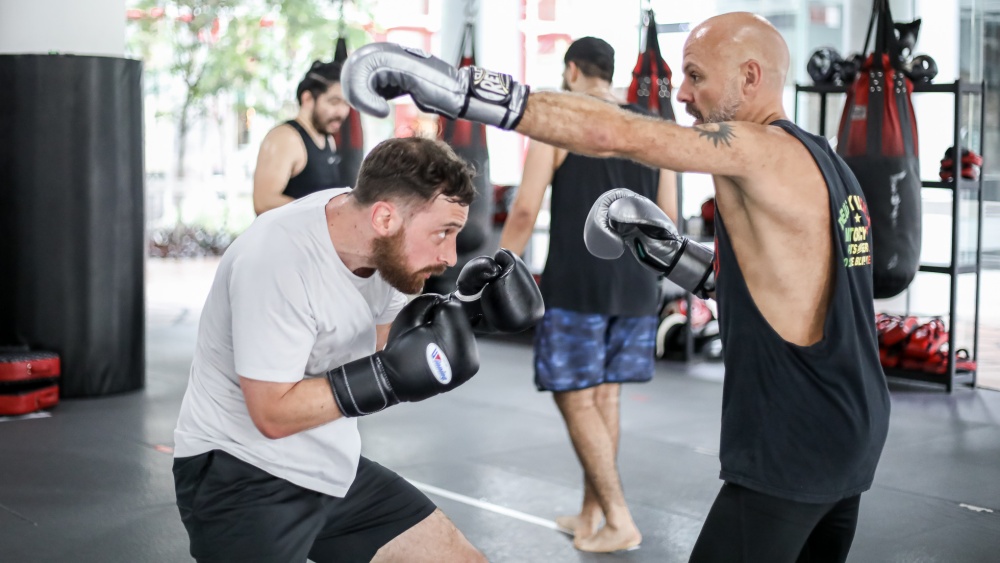Boxing ring generalship is a technical term used to describe the control of the action inside the ring. Using a combination of footwork and punching, a boxer will use ring generalship to gain an advantageous position in order to land clean punches, or to force an opponent to move and react in a specific way.
With ring generalship, you can dictate the pace of the action. You can maneuver your foes, and move them where you want them to be without them realizing it. You can bait them into throwing certain punches, lay traps until they are cornered or leaning against the ropes. You can also make opponents chase you until they tire out, goad them into launching an attack as you disappear from their centerline.
Ring generalship is one of the main scoring criteria in a professional boxing match, making it one of the most important aspects of a fight. The fighter who controls the ring, usually controls the fight and comes out on top.
If you want to add ring generalship to your boxing game, you’ve come to the right place. We’ve listed down five things for you to try the next time you’re in the gym. These tips will help you become a better ring tactician.
Today, Evolve Daily shares five ways to improve ring generalship for boxing.
1) Master Basic Movement
The first step to becoming a more commanding ring general is to master basic movement. When your footwork becomes second nature, and you’re not actively thinking about moving your feet in a certain way, only then can you put everything together to combine movement with strategy.
Start by mastering lateral, side-to-side movement, shuffling left and right, and circling. Learn how to dart in and out of range with forward and backward movement. Practice pivoting and sidestepping to gain the ability to force your opponents in certain directions.
It’s important that you set aside at least 15 minutes of training and dedicate it to honing basic movement and footwork. Training this aspect of your game each day will help bake moves into your muscle memory.
Once you’ve mastered the basics and have built a solid foundation of fundamentals, then you can take the next step and add strategic movement to your ring generalship skills.
2) Move In Angles
Angles are a significant part of boxing. Coaches will always instruct their students to move off the centerline, entering and exiting range by using angles. This keeps from opponents being able to reach you straight down the middle with their length.
By moving in angles, you reduce the risk of getting caught by a punch you don’t see coming. At the same time, using angles also gives you the opportunity to create avenues of attack, and hit your opponent from positions where he or she is most vulnerable.
Use your footwork to sidestep and move in and out of range from the left or right side. You don’t want to move straight back to get away from an opponent’s offense, and you don’t want to attack straight down the middle too often as well.
Learning how to use angles will make you a very dangerous fighter who can use all axes of movement as an advantage.
3) Win The Positioning Battle

On the surface, it may seem that two fighters in the ring are just throwing hands, trading punches without much thought. But peel back the complex layers of the discipline, and there are many micro battles taking place in every round. One of those is the battle for position.
Foot positioning is a very important aspect of every fight. Having good foot positioning provides you with great balance without impeding your movement. At the highest levels of competition, fighters are always jockeying for superior foot position in the ring.
Your lead foot must constantly be on the opposite side of your opponent’s lead foot, with the ability to pivot away from an opponent’s power hand. By keeping your foot in this position, you can easily circle away from danger when needed. This, however, gets tricky when you’re facing a southpaw.
Against a southpaw, your lead foot has to stay outside of your opponent’s lead foot to keep you balanced, otherwise, you’ll be open down the middle, and your balance will be compromised. Use quick, explosive, and intelligent movement to win the positioning battle.
4) Cut Off The Ring
A standard-sized boxing ring is between 16-20 feet on each side, and great fighters know exactly how to maximize every inch of it. Those who control the expanse of the ring, control where their opponents go and how they move.
Sound defensive fighters will often use a lot of lateral movement to circle around the ring. They are elusive and hard to catch, and even harder to trap along the ropes or in corners. One common mistake that aggressive offensive fighters make is that they try to chase their opponents around the ring.
If you know how to cut off the ring and limit the space where your opponent can move, however, you will have the upper hand. This is done by anticipating the direction an opponent is moving, and beating him to that spot with your own lateral movement. That effectively seals off a huge chunk of the canvas.
The objective is to corner your opponents so they don’t have many options of movement or escape. Don’t chase them around and expend unnecessary energy doing so.
5) Don’t Forget To Punch
Movement is nothing without a consistent attack. You can move all you want in the ring, but if your opponent isn’t threatened by your attacks, then your ring generalship will not be effective. Don’t forget to punch while moving.
Use your jab to fight your way to the inside. Come into range with a combination paired with good head movement. At the same time, use your jab to punch yourself out of harm’s way. Duck and under after throwing your hook, or explode out of range following an uppercut. Whatever you do, and whichever way you decide to move, don’t forget to throw punches.
Remember, when you’re not punching, your opponent definitely is.
Furthermore, incorporate feints into your game and add them to your combinations. Feints are great at eliciting reactions from opponents, and forcing them to freeze and become hesitant. Feinting movement is an important component of good ring generalship.
You may also like:
















